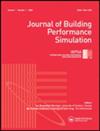建筑围护结构封闭空间热阻数值预测的数据驱动数值模型
IF 2.3
4区 工程技术
Q2 CONSTRUCTION & BUILDING TECHNOLOGY
引用次数: 0
摘要
封闭空气空间(EAs)是建筑围护结构中不同节能技术的共同组成部分,在各种气候条件下具有内在的适应性行为。针对不同的应用,仍然需要不加限制的全面准确的数值模型。因此,第一次,机器学习和基于回归的技术(普通最小二乘线性回归(OLR),支持向量回归(SVR),核脊回归(KRR), k-近邻(kNN), r-近邻(rNN)和人工神经网络(ANN))被应用于开发精确的模型,这些模型来自最可信的实验数据,具有几次运行的随机测试和训练逻辑。结果发现,KRR、SVR和ANN的应用获得了最理想的结果,R2最高(0.97-0.99),误差最低,而OLR不能提供令人满意的结果(R2 <0.6)。此外,OLR、kNN和rNN计算结果在热流方向向下的水平ea(厚度= 40mm)中偏差较大。本文章由计算机程序翻译,如有差异,请以英文原文为准。
Data-driven numerical models for the prediction of the thermal resistance value of the Enclosed Airspaces (EAs) in building envelopes
ABSTRACT Enclosed airspaces (EAs) are a common component of different energy efficient technologies in building envelopes which have intrinsic adaptive behavior under various climatic conditions. The need for comprehensive accurate numerical models without restrictions for different applications still exists. Thus, for the first time, machine learning and regression-based techniques (Ordinary least squares Linear Regression (OLR), Support Vector Regression (SVR), Kernel Ridge Regression (KRR), k-Nearest Neighbors (kNN), r-Nearest Neighbors (rNN), and Artificial Neural Network (ANN)) were applied to develop precise models derived from the most credible experimental data with stochastic logic of testing and training in several runs. It was found that application of KRR, SVR, and ANN leads to the most desirable outcomes with highest R2 (0.97–0.99), and lowest errors, however OLR does not provide satisfactory results (R2 <0.6). Moreover, major deviations are observed for calculations by OLR, kNN, and rNN in horizontal EAs (thicknesses = 40mm) with downward heat flow direction.
求助全文
通过发布文献求助,成功后即可免费获取论文全文。
去求助
来源期刊

Journal of Building Performance Simulation
CONSTRUCTION & BUILDING TECHNOLOGY-
CiteScore
5.50
自引率
12.00%
发文量
55
审稿时长
12 months
期刊介绍:
The Journal of Building Performance Simulation (JBPS) aims to make a substantial and lasting contribution to the international building community by supporting our authors and the high-quality, original research they submit. The journal also offers a forum for original review papers and researched case studies
We welcome building performance simulation contributions that explore the following topics related to buildings and communities:
-Theoretical aspects related to modelling and simulating the physical processes (thermal, air flow, moisture, lighting, acoustics).
-Theoretical aspects related to modelling and simulating conventional and innovative energy conversion, storage, distribution, and control systems.
-Theoretical aspects related to occupants, weather data, and other boundary conditions.
-Methods and algorithms for optimizing the performance of buildings and communities and the systems which service them, including interaction with the electrical grid.
-Uncertainty, sensitivity analysis, and calibration.
-Methods and algorithms for validating models and for verifying solution methods and tools.
-Development and validation of controls-oriented models that are appropriate for model predictive control and/or automated fault detection and diagnostics.
-Techniques for educating and training tool users.
-Software development techniques and interoperability issues with direct applicability to building performance simulation.
-Case studies involving the application of building performance simulation for any stage of the design, construction, commissioning, operation, or management of buildings and the systems which service them are welcomed if they include validation or aspects that make a novel contribution to the knowledge base.
 求助内容:
求助内容: 应助结果提醒方式:
应助结果提醒方式:


